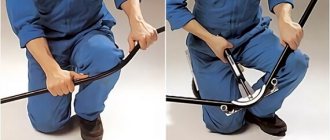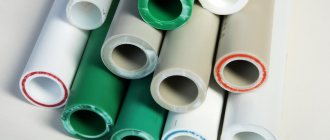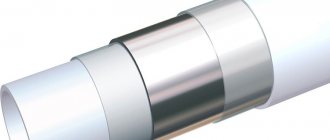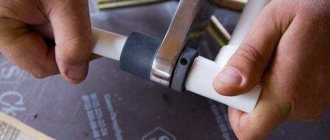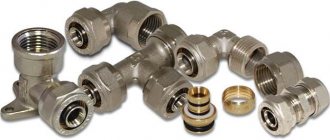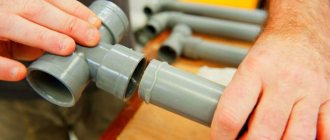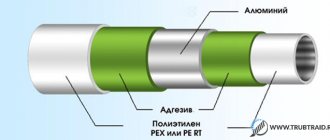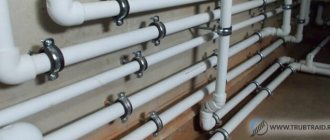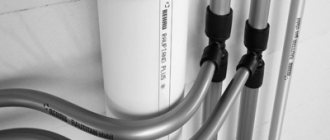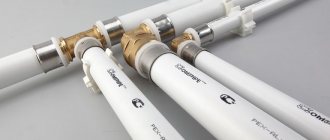With the advent of polypropylene, metal-plastic pipes for water supply systems have somewhat lost their former popularity. The main reason for this is leaks at the connection points with the fitting, which occur after some time of operation. Is the material to blame for this, or are there typical installation errors? We will try to answer this question in the course of this article.
Metal-plastic pipes for water supply
Materials from which metal-plastic pipes are made
Metal-plastic pipes are made of metal and plastic layers laid one inside the other. Such products combine all the best qualities of the materials used. They are able to withstand high temperatures up to 95 degrees, are flexible and durable, which ensures reliability and durability of use.
The multi-layer structure was created and developed to prevent mechanical damage, air ingress and possible expansion of the pipe due to thermal effects. The appearance of rust, limescale build-up, scale and ulceration from aggressive substances is also completely excluded due to the ideal smoothness of the pipe cavity.
Metal-plastic pipes made of various materials Source glawtruba.ru
The surface of the pipe consists of a thermoplastic high-strength material, which provides it with high hardness and strength. It's called polyvinyl chloride, or PVC. The internal space is lined with a polyethylene layer. The aluminum shell is located in the middle, between these two layers. All layers are fastened together using an adhesive layer. The following types of plastic are used in production:
- polyethylene;
- polymer resistant to extreme temperatures;
- polypropylene;
- polyethylene that can withstand high pressure.
The glue firmly adheres the layers and makes the pipe solid, monolithic. The core of the pipe is made of metal reinforcement and is designed to provide temperature stability and additional strength. Despite their hardness, the products have sufficient elasticity, and the light weight of aluminum significantly reduces the weight of the pipeline. Thanks to its flexibility, the pipe can be easily given any desired shape.
Layers of metal-plastic pipes Source pechky.ru
Binding component
To bind metal and plastic together, specialized compounds are used, through the use of which it is possible to create multilayer structures that form a single whole. It is difficult to accurately name the brand of glue, as well as the components included in its composition, since companies keep this information secret.
Buyers have no choice but to check the certificates for such products and make sure they are safe. The glue is used as a bonding layer and gives the product elasticity. This material is one of the most vulnerable points in the pipe. If elasticity decreases, the product will separate into layers and leak. The metal-plastic pipe must be equipped with a high-quality bonding layer. Delamination should not be noticeable on the cut of the material. Having discovered that the bonding of the constituent elements is not strong enough, it is hardly necessary to talk about the reliability of such a material.
Purposes of using metal-plastic pipes
Metal-plastic pipes are used on a wide domestic and industrial scale, for example, in the construction of houses. Metal-plastic pipes are used for heating, water supply and sewerage systems. You can also use them to lay a structure for heated floors. In industrial areas, such pipes are used for gas pipelines and the supply of hazardous chemicals - liquid or diffuse.
Sometimes you can find unconventional uses of pipes, for example, as a mounting block in which wires and electrical cables can be laid and hidden. This method of insulation is safe and durable. Metal-plastic serves well in ventilation and air conditioning systems.
Warm floor made of metal-plastic pipes Source pol-spec.ru
Types of metal-plastic pipes
The sizes of metal-plastic pipes vary in length, wall thickness, and cross-sectional diameter. They also differ in their composition, strength, heat resistance and bending radius. The permissible wall thickness is up to three millimeters. The length of the pipe can reach two hundred meters. The diameter of metal-plastic pipes can reach up to six centimeters. For more detailed characteristics and diameters of metal-plastic pipes in the size table, see the table:
| Pipe outer diameter (mm) | 16 | 20 | 26 | 32 | 40 |
| Inner diameter (mm) | 12 | 16 | 20 | 26 | 33 |
| Pipe wall thickness (mm) | 2,0 | 2,0 | 3,0 | 3,0 | 3,5 |
| Weight of one meter of pipe (g) | 115 | 170 | 300 | 370 | 430 |
| Volume of liquid in one meter of pipe (liter) | 0,113 | 0,201 | 0,314 | 0,531 | 0,855 |
| Manual bending radius (mm) | 80 | 100 | 110 | 160 | 550 |
| Bending radius using pipe bender (mm) | 45 | 60 | 95 | 125 | 180 |
| Maximum temperature (short term) | 130 Celsius | ||||
On sale you can find pipes in a variety of colors, although the most popular shade is white. The cost of one linear meter will depend on several physical parameters - the type and purpose of the pipe, technical characteristics and capabilities.
Colors of metal-plastic pipes: white, black, blue, red and green Source moybiznes.org
Marking
The metal-plastic pipe has its own marking, which is not washed off and runs along its entire length. Before making a choice and purchase, it would be useful to get acquainted with its designations. The marking indicates technical features and physical parameters, instructions from GOSTs and standards according to which the pipe is manufactured, and the name of the manufacturer. Including designations of the type of material, which has the following marks: heat-resistant - PERT, cross-linked - PE-X, polyethylene - PE-R; aluminum – AL.
Cross-linked polyethylene is high-density ethylene, which was formed through physical, chemical or combined effects in production. Crosslinking can be achieved in several ways:
- using nitrogen, this cross-linking is called nitrogen cross-linking
- peroxide;
- using silane;
- electronic welding.
Marking of metal-plastic pipes Source montagtrub.ru
The width of the pipe wall, or the diameter of its cross-section, is usually indicated in millimeters, but sometimes it is also found in inches. The marking also contains data on the intended purpose of the pipe - for supplying drinking water, or only for technical use. Additional parameters in the form of normal operating pressure and maximum temperature conditions are also included in the marking. It is also necessary to indicate the month and year of production, and the number of the finished batch. Each manufacturer includes its own data in the labeling, so the number of characters will vary from company to company.
An example of gas pipe marking Source trubadelo.ru
See also: Catalog of companies that specialize in water supply and sewerage.
Pros and cons of metal-plastic pipes
A pipeline made of metal-plastic mains will last up to fifty years. If it is used in a hot water supply network, its service life reaches twenty-five years. All engineering communications operate absolutely silently. Other additional benefits include:
- flexibility and elasticity - allow you to fix the pipeline without the use of individual parts (angles and connecting devices);
- immunity and resistance of pipe shells to gases and aggressive chemical composition;
- absence of corrosion damage;
- tightness;
- little weight;
- convenient transportation due to the compactness of the products;
- ease of installation;
- beautiful aesthetic appearance;
- low acceptable cost;
- environmental friendliness and safety for the health of animals and people;
- low thermal conductivity - you can’t get burned;
- waste-free.
Installation of a metal-plastic pipeline Source saw-wood.com
Along with the undoubted positive characteristics, there are also some disadvantages in using metal-plastic pipes for water supply. They cannot be bent or unbent repeatedly in the same place. This leads to internal damage to the composite shells. Twisting in a circle is not possible. In addition, delamination can also occur in poorly manufactured products. When using pipes at sub-zero temperatures, additional thermal insulation is required.
Also, the disadvantages include the impossibility of using the pipe in too hot conditions (if the temperature can reach 150 degrees). The pressure in the hot medium working pipe should not exceed ten bar.
In addition, metal-plastic is not suitable for heating when installed in a central network. This is due to the fact that when carrying out preventive measures, the water can reach a temperature of one hundred and fifty degrees. Only strong metal structures can withstand such a water hammer. Failure to comply with this recommendation may lead to damage and subsequent destruction of the metal-plastic heating pipe. Such troubles can be avoided by additionally integrating a temperature regulator and a pressure stabilizer.
Metal-plastic pipes for water supply Source alfatep.ru
Existing disadvantages
Along with these advantages, metal-plastic pipes also have disadvantages:
- The push-in compression connection remains dismountable throughout its entire service life. The use of crimping can remove this factor, but will require additional investments in the purchase of expensive tools and will reduce the convenience of operation.
- Despite the fact that the flexible pipe has the ability to bend, the bend location can lead to deformation and destruction of the internal aluminum profile. If you use special fittings for corners and turns, you can reduce the likelihood of damage, but this will increase the cost of purchasing material.
- The operating temperature precludes the use of metal-plastic pipes without installing additional thermal mixing units when operating solid fuel boilers.
Installation of water supply
Every engineering solution begins with a design on paper. The pipe distribution is drawn indicating the end and stopping points (sink, faucet, radiator, etc.). Accurate visual design significantly reduces financial and labor costs.
The project plan indicates the initial starting location for water intake. This could be a deep private well or a central water supply system. If a well is used, then in this case it will be more cost-effective to use a water battery - a metal or concrete accumulator. With its help, you don’t have to activate the pump, because the water flows by gravity directly into the living space and passes through the filter system.
If you plan to tie into a central water supply system, then water meters must be included in the project. This will reduce utility bills and ensure consumption metering and control of water consumption. Purification filters are selected taking into account the individual characteristics of the initial composition of water. For this reason, recommendations may vary.
Installation of metal-plastic pipes Source shutdownday.org
Video description
The secret of connecting metal-plastic pipes
With the open installation method, the pipes are laid directly along the wall itself or along the floor. This method is used when it is impossible to hide the pipes. But since the appearance of the pipes is quite aesthetic, this method is widespread and is a budget option. Among other things, open installation is very convenient for repairing pipes and maintaining cleanliness. In case of combined installation, pipes are sealed with plastic panels or special boxes made specifically for the required size.
First, installation locations are outlined and measurements are taken. The pipes are cut to the required length. The resulting cut elements are laid out on the markings made. Next, the metal-plastic pipes are connected with fittings. To decide how to connect a metal-plastic pipe to each other, you need to understand which method will be the most convenient. The connection is possible in a detachable (collapsible) or permanent (iron coupling) way.
Fittings for connecting metal-plastic pipes Source banyabest.ru
The detachable method is very convenient and is carried out using a collet connector, which has a spring bushing. This fitting is expensive, but if necessary, it can be disassembled and used again. It is made of brass alloy and is secured with a ferrule inside the housing. Also, a compression connecting element can be used for this method.
The process of connecting pipes is as follows. A nut and collet are put on the pipe. A fitting is inserted inside the pipe, onto which the union nut is screwed. The same is done with the second pipe. This results in a strong and reliable connection.
A one-piece connection method is possible when using push fittings and press fittings. The connection of metal-plastic pipes can be angular, straight or triple. In order to decide how to connect metal-plastic pipes, it is advisable to take into account the installation location.
Pressure testing of a metal-plastic pipe Source lammin.org
A simple connection method includes crimping metal-plastic pipes. This method is also called a crimp connection. For this activity you will need crimping pliers, a fitting, a ferrule and a union nut. Pressure testing is often used in laying heated floors using a press fitting, or for cold water supply, where a compression fitting is used. Control holes in the form of windows are made for hidden installations. The water supply is attached to the wall with clamps or clamps. If it is used in a heated floor system, then fixation occurs in special underlay mats.
Wiring Features
The term “wiring” is familiar to users, but not every person understands its meaning. This word should be understood as a whole system: plumbing, faucets, filtering devices, meters. There are several wiring methods, but in order to make a choice, you need to study them in more detail.
Table No. 3. Pipeline laying methods.
| Method, illustration | Description |
| Used in small apartments and private settings where there are a minimum number of connection points. This wiring method involves installing tees on pipes. So, you get a miniature system with a small number of connections. In addition, you don’t have to spend a lot of time on such installation. Of the negative aspects of the wiring, it is worth noting that after opening several taps, the overall pressure decreases. |
| This method is used when it is necessary to connect many points to one system. The main parts here are manifolds, thanks to which even when several taps are opened, the pressure remains stable. After which the water is transported to the plumbing fixtures. They are mounted separately for water supply systems of different temperatures. So, if you stop the water supply to one device, this does not affect other devices. |
| In this case, the devices are connected in one system using the two methods listed above. |
Rules for choosing metal-plastic pipes
In order to make an excellent choice and not make a mistake in purchasing, you need to pay attention to some points:
- First of all, you need to decide on the purpose of the pipe. How and where it will be used, under what conditions.
First of all, you need to pay attention to the type of material; it is indicated in the form of markings on the entire surface of the pipe. When making a virtual choice, for example, on any website, all physical characteristics must be indicated in the description. If necessary, you can clarify this issue with consultants.
Product maintenance rules
In order to achieve long-term operation of the water supply system, you must adhere to some rules:
- Use collectors when installing the network. This will allow you to disable only individual points.
- Monitor your pressure level. As a rule, structures can withstand a load of no more than ten atmospheres.
You can read more about water pressure in the water supply in our special article.
- Do not install products outdoors, because the polyethylene surface is destroyed when exposed to the sun.
- Avoid contact with sources of fire.
- Use special sleeves if necessary to pass pipes through the ceilings.
- Avoid constant temperature fluctuations.
- Installation of the water supply system should be carried out at a temperature of about ten degrees.
Due to water hammer, rupture often occurs
Video description
Selecting metal-plastic pipes for home heating
- The material used to make all pipes is polyethylene, but it can be of different quality.
Low pressure plastic will age quickly if exposed to direct sunlight. This will contribute to rapid wear and render the pipe unusable. At hot temperatures of more than seventy-five degrees Celsius, such products quickly collapse.
- To choose an acceptable quality, you can consider polyethylene, which is made using technical cross-linking or bonding.
The cross-linking technology is marked with the PEX mark. It is the most hardened, which means that such a material can withstand high pressure and temperature for a long time.
Some lowercase Latin letters are usually assigned to such a sign, which indicate the stitching method. For example, c is a physical method, a or b is a chemical method. Usually this does not particularly affect the overall quality of the material, but in the case of using pipes for coolant at ninety degrees, it is advisable to opt for the PEXb marking.
Width of aluminum reinforcement and marking Source trubadelo.ru
- The width of the aluminum reinforcement in the middle of the pipe is the main consideration when choosing.
The greater the thickness, the higher the strength of the product, but the flexibility and elasticity will be worse than that of pipes with a thin layer of aluminum. The common width of the metal is considered to be 0.3 millimeters. Some manufacturing plants do not consider it necessary to print this parameter on the pipe. Thus, they report that everything is manufactured within the framework of government quality standards and meets safety requirements.
How to repair
What to do if multilayer metal-polymer pipes for hot water supply leak at the fitting connection due to installation errors?
Fortunately, this type of connection is serviceable and can be dismantled:
- Unscrew the union nut and slide the split ring;
- Remove the pipe from the fitting with force;
- Calibrate it and remove the internal chamfer;
- Install the O-rings into the standard grooves. If they are torn, replace the seals (or, if they are missing, the entire fitting);
- Lubricate the fitting and reassemble the connection.
Briefly about the main thing
Metal-plastic pipes can withstand high temperatures up to 95 degrees. They are distinguished by flexibility and increased strength, which ensures reliability and durability of use.
Metal-plastic pipes are used on a wide domestic and industrial scale, for example, in the construction of houses. They are also used for heating, water supply and sewage disposal.
Metal-plastic pipes vary in length, wall thickness, cross-sectional diameter, composition, strength, heat resistance and bending radius, as well as purposes of use.
The main advantage of such pipes is their durability (up to 50 years). One of the disadvantages is the impossibility of using pipes for coolants that are too hot.
The choice of metal-plastic pipe depends on the purpose of application, as well as the type of material. The decisive factor in choosing a product is whether the quality of the pipe matches its cost.
Ratings 0
No. 5. Type of plastic in the inner and outer layer
The following types of plastic are used for the production of metal-plastic pipes :
- cross-linked polyethylene PEX and linear polyethylene PE-RT. They provide pipes with maximum strength, reliability and resistance to various types of loads. Such products better withstand mechanical stress, temperature and pressure changes in the system, and have a long service life. To install a hot water supply or heating system, it is better to take just such pipes;
- low-pressure polyethylene (in the marking of pipes it can be designated by abbreviations such as PEHD, PE-RS, PE or HDPE) is also used in the production of metal-plastic pipes, but significantly narrows the scope of their use. This polymer is not able to withstand temperatures above +750C, therefore it is used exclusively for transporting cold water. In addition, it wears out quickly when exposed to direct ultraviolet rays, so it is advisable to protect the pipes from sunlight. Pipes made of low-density polyethylene are cheaper, but if operating conditions are observed, they can last for decades.
